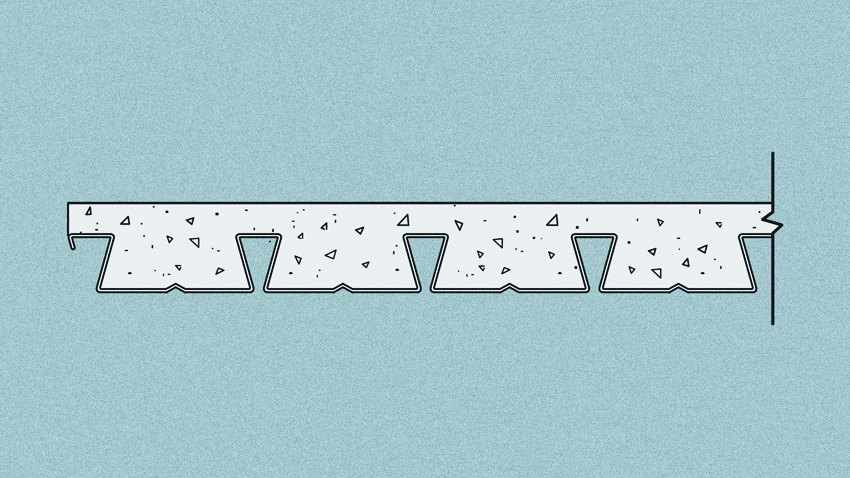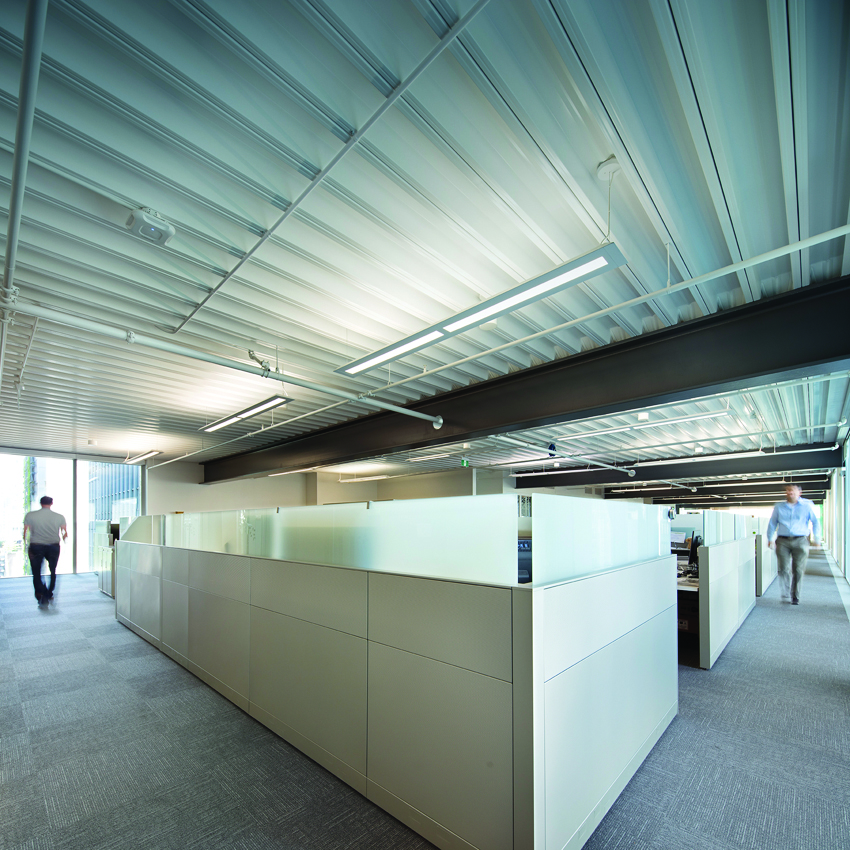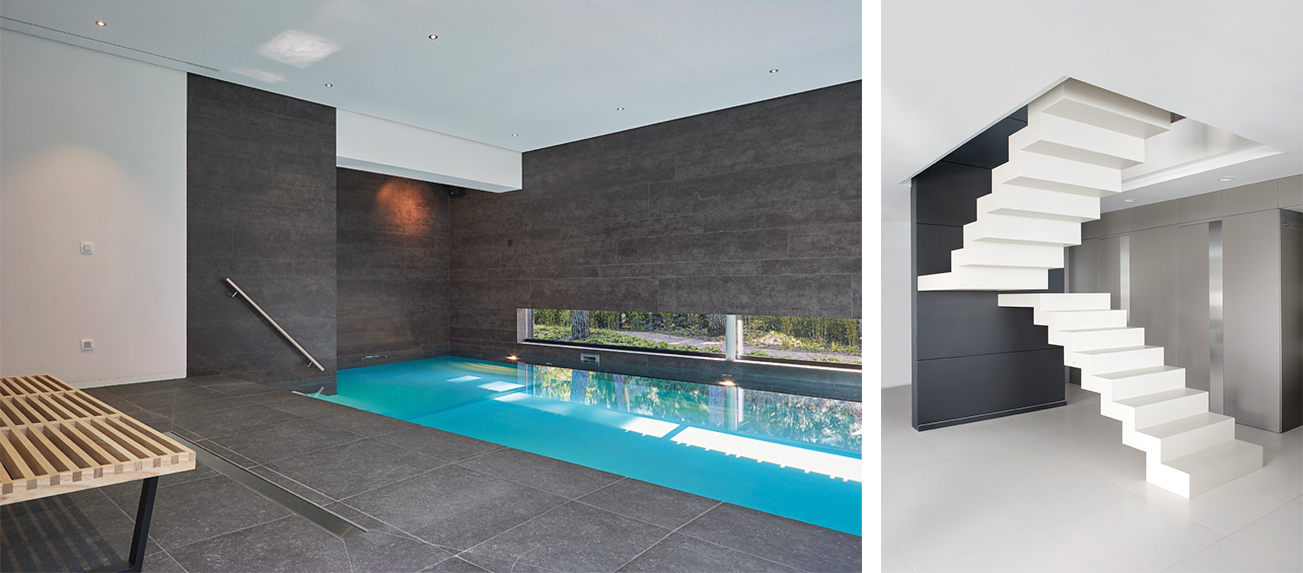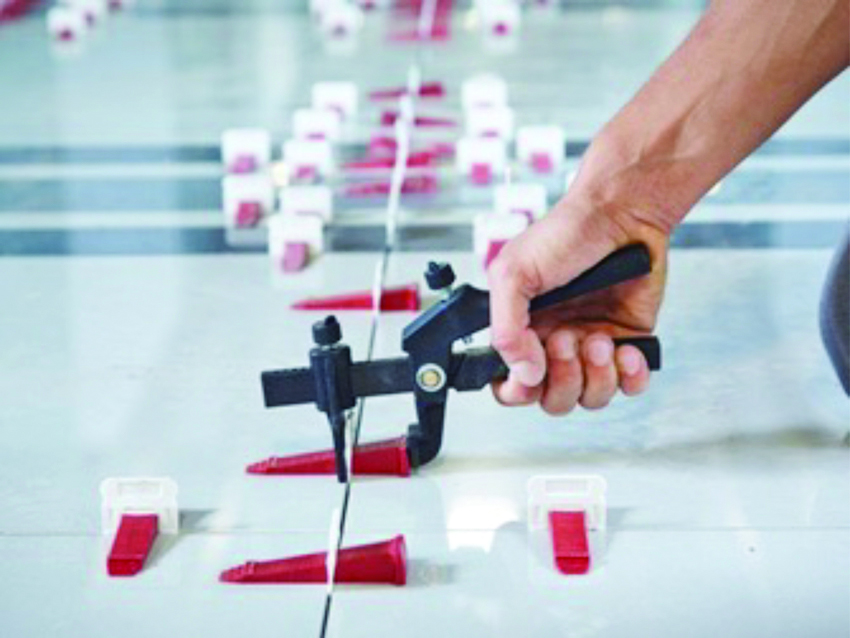Specifying Flooring from the Bottom Up
A unique feature of the deep-deck composite floor system is construction cost-efficiency. The deck sections can be side-lapped together on the ground by an installation crew using a fastening tool. When ready, the panelized sections can be crane lifted together into place, allowing the deck to provide double duty as a work platform for safer and more efficient pours. Further, deep-ribbed decking commonly has enough structural strength to be installed without any shoring or supports underneath it for spans up to 22 feet, thus offering faster and even more cost-effective construction.
Dovetail deck composite floor systems: The name of this floor system comes from the dovetail-shaped profile of the corrugated metal deck that receives the concrete and bonds firmly with it. This can provide extra rigidity and strength that allows finish flooring to function properly without fear of deflection or movement. Dovetail composite floor systems are available in 2-inch and 3.5-inch dovetail profiles, meaning this floor system offers the thinnest total floor depths. With a finished thickness as thin as 4 inches, this system can be used to reduce story heights and maximize ceiling heights. The thinner profiles do mean that they are best suited for shorter spans with the capability of supporting clear spans up to 28 feet. Nonetheless, the deck can serve as the finished ceiling too while allowing some smaller electrical and plumbing lines to be run in the dovetails and concealed from view.

Image courtesy of New Millennium Building Systems
Dovetail deck composite floor systems can span up to 28 feet and provide a ceiling appearance with a smooth, linear plank aesthetic.
Dovetail deck composite floor systems can be particularly useful in mid-rise or multistory residential projects, such as hotels, health-care communities, and dormitories where structural walls between occupant units can support the floor deck without the need for intermediate supports. As such, it can be integrated with panelized cold-formed steel-stud wall systems or supported by structural beam and bearing-wall systems.
At least one manufacturer of all three of these composite floor systems can offer in-house engineering support to consult with project design teams. In this regard, it can advise on the appropriateness of the different system types and the specification options throughout the design process. For projects striving for more sustainability, the manufacturer can provide data showing that a long-span composite floor system can use up to 40 percent less concrete than poured-in-place concrete floors. As such, long-span composite floor systems align well with LEED v4 requirements because they support a holistic, long-term view of project performance and costs, both to the building owner and the environment. Additionally, they allow for open, unobstructed building spaces, making it easier for future interior layout changes or moves.

Photo courtesy of New Millennium Building Systems
The open floor plan and towering open spaces of this office project feature an attractive and economical deep-deck long-span composite floor system.
Economical and Forward-Thinking Floor Solutions
Project costs and environmental concerns weigh heavily on the minds of many building designers, and long-span composite floor system can help address these, notes Sean Smith, market development manager for New Millennium Building Systems. “A building’s shallower floor structure can contribute to a reduction in building height,” he explains. “A shorter building, even if it is merely a few feet shorter, can potentially save the owner hundreds of thousands of dollars on exterior cladding materials. The reduction in building material also equates to reduced impact on our environment. And keep in mind, structural steel can have a high amount of recycled content.”
A recent 20-story hotel project is a good example of this. It called for clear spans of 26 feet, one row of shoring, and acoustic and vibration testing. When considering the three types of long-span composite floors, the longer composite joist option was removed from consideration, leaving deep-ribbed composite floors and dovetail composite floors to consider. The decision to use 3.5-inch dovetail composite came down to one distinguishing factor: while meeting other requirements, the dovetail composite floor also presented a significantly thinner overall structural floor depth. When multiplied over the 20 floors of the building, the height reduction and corresponding savings on facade materials was significant.
Sintered Stone Flooring Performance
Once the performance of the subfloor is determined to be suitable, then the selection of the finished flooring can be addressed based on the flooring performance needs of the project. Sintered stone has become a flooring material of choice for architects, designers, specifiers, and fabricators not only because of its versatile and appealing design traits but also for its impressive performance characteristics. As such, it has been specified for the most demanding interior and exterior flooring application projects. It has been viewed as a premium option that balances high performance and aesthetic appeal with long-lasting, resilient products warrantied for up to 25 years.
As a material, we have already touched on some of the properties of sintered stone that impact its performance. Its density contributes to it being waterproof, hygienic, and resistant to scratches, heat, chemicals, and ultraviolet radiation. This exceptional resilience makes it ideal for high-traffic uses, such as flooring exposed to high footfall in busy public spaces. It is equally suitable for locations that may have less foot traffic but more potential for damage from harsh conditions, abrasive activities, or concern over vandalism.
Slip resistance: Sintered stone also addresses a common safety criterion for floors in public spaces; namely, the tested slip resistance of the flooring material. Up until 2014, the standard test was based on a static coefficient of friction (SCOF) following specific testing procedures developed by ASTM International. Since then, the new test standard has been based on a dynamic coefficient of friction (DCOF) that tests for slip resistance based on an object being already in motion—in other words, more closely aligned with a person walking along the floor. The industry standard for achieving appropriate slip resistance in flooring is a tested 0.42 DCOF. Since sintered stone products can be produced with different surface types, they can produce different DCOF ratings. Many, however, have been tested and shown to meet or exceed this safety test standard, making them very suitable for all types of flooring applications. They are particularly appealing for high-foot-traffic areas like lobbies and hallways, plus wet areas like swimming pools, bathrooms, and kitchens.

Photos courtesy of Neolith®
Sintered stone can be specified to meet needed slip resistance for flooring, which is particularly important in areas like swimming pools and stairs.
Interior stairs are another area where sintered stone has been used successfully, particularly where appearance, durability, and slip resistance are key criteria. In these situations, the sintered stone can be cut to cover the treads and risers and even integrate with adjacent walls, balusters, etc. Standard safety nosings can be incorporated as may be needed, or the material can be used to fully cover the stairs.
Installation: Sintered stone panels and slabs are available in large-format sizes requiring less labor and allowing for shorter installation times, thus making them cost-effective to install. Relatedly, they are easily fit into place using known site cutting and handling techniques for large-format tile. The cut and prepared pieces can then be installed using common thin-set application processes. Hence, while the material may be new to some, the process and procedures for installing it will be familiar to most experienced installers of large-format tile. This familiarity should help ensure that it performs as expected for its useful life in the building.
Before installing sintered stone flooring, the underlying subfloor or substrate needs to be flat and clean as with any large-format product. If the substrate planarity or level is out of allowable tolerances (e.g., more than 1/8 inch for every 10 feet), the substrate needs to be prepared or repaired and leveled to bring the substrate within tolerances. Even with that done, however, the likelihood that the subfloor is absolutely level is not always guaranteed. Therefore, it is important to address any remaining irregularities so they are not an issue once the flooring is installed. Self-leveling materials or isolation crack membranes are always recommended where those are appropriate to help ensure best results. In many cases, though, the best way to overcome a slightly irregular subfloor is by using a leveling system that consists of a combination of supports placed under the floor tiles and wedges inserted into the supports. This type of leveling system offers the advantages of 1) helping to lay a clean and level floor, 2) ensuring the floor tiles or slabs are more firmly joined to the adhesive for stronger and more long-lasting installations, 3) reducing the slab installation time, and 4) reducing the need to lift up the slabs again to add more adhesive.

Photo courtesy of Neolith®
The best way to assure that a sintered stone or tile finished floor is level and flat is to use a leveling system that keeps the floor pieces aligned with each other.
The installation of this type of system often follows a three-step process—arranging the supports, inserting the wedges, and removing the supports—which is detailed as follows.
- Arranging the supports: After applying adhesive to the tile/slab, the leveling supports need to be inserted under the slab along all four sides. For large-format slabs, more than one clip along each side will be needed. Then the slab can be positioned in place as per the manufacturer’s recommendations.
- Insert the wedges: With the slab in place, the wedges can be inserted in the support grooves. This must be done carefully so as not to push the wedges beyond the fracture point.
- Remove the supports: After the adhesive sets, the supports can be removed by separating the part sticking out of the base support.
When used correctly, a leveling system will make installing large-format slabs easy work, with greater reliability and higher likelihood that it will perform as intended.
Among some other best practices for sintered stone flooring installation, thin-set mortar or adhesive should be applied to both the substrate and the sintered stone in a “double-buttering” method to ensure full adhesion. The material itself can be precut by the manufacturer or field cut using conventional cutting tools for tile. Either way, the manufacturer’s instructions and recommendations need to be followed for the proper handling, adhering, grouting, and joint work to achieve best results. After the grout is installed, the panels should be cleaned with a damp cloth to remove any excess grout, sealants, or other contaminants. Manufacturers will often provide some standard guidelines to help avoid installation mishaps.
Conclusion
Flooring is a significant interior design feature of a building. It provides a far-reaching aesthetic as part of an overall design concept. The floor structure is the place to start to ensure that best results are achieved. Long-span composite flooring systems have been shown to be ideal in many types of buildings, particularly when the economy of the structure is important. For finish flooring, sintered stone is becoming a product of choice for many building types. Its proven properties of being a natural, lightweight material available in many different colors and surface appearances is getting the attention of architects and interior designers. Its high-performance properties also make it an excellent choice for those concerned with long-term durability and life-cycle costs. Architects who consider how the subfloor structure and finish flooring work together, as presented in this course, can be more assured in the overall success of a total floor system.
Notice


www.newmill.com









